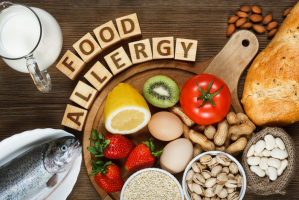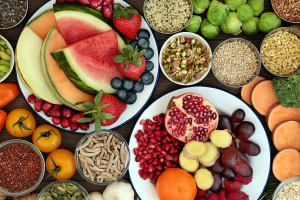Top 9 Most Common Food Intolerances
Food intolerances are not deadly, unlike other allergies. However, for those who are affected, they can be very problematic. Food sensitivities and ... read more...intolerances are common and tend to be on the rise. In fact, experts believe that up to 20% of people worldwide may have a food intolerance. Due to the variety of symptoms they might cause, food intolerances and sensitivities can be challenging to identify. Continue reading to find out Most Common Food Intolerances that are listed below!
-
Milk and other dairy products contain a sugar called lactose. In order for lactose to be effectively digested and absorbed, it must be broken down by an enzyme called lactase in the body. Lack of lactase enzymes results in lactose intolerance, which impairs the ability to digest lactose and leads to digestive symptoms. Lactose intolerance symptoms include: abdominal pain, bloating. diarrhea, gas, nausea,...
The intolerance to lactose is quite common. In fact, lactose digesting problems are thought to affect 65% of the world's population. There are numerous methods for diagnosing intolerance, such as a lactose-tolerance test, lactose breath test, or stool PH test. Avoid dairy products that contain lactose, such as milk and ice cream, if you think you may be lactose intolerant. As they contain less lactose than other dairy products, aged cheeses and fermented foods like kefir may be easier for those with lactose intolerance to tolerate.

Dairy 
Dairy -
The term "gluten" is used to refer to the proteins that are found in wheat, barley, rye, and triticale. Gluten is a factor in a number of illnesses, such as celiac disease, non-celiac gluten sensitivity, and wheat allergy.
Even when testing negative for celiac disease or a wheat allergy, many people still have unpleasant symptoms. This condition is referred to as non-celiac gluten sensitivity, a milder type of gluten intolerance that affects somewhere between 0.5 and 13% of the population. Similar to celiac disease symptoms, non-celiac gluten sensitivity symptoms include: bloating, abdominal pain, diarrhea, constipation, headaches, fatigue, joint pain, skin rash, depression or anxiety, anemia,... Both celiac disease and non-celiac gluten sensitivity are managed with a gluten-free diet. It involves following a diet devoid of anything with gluten in it, such as bread, pasta, cereals, beer, baked goods, crackers, sauces, dressing and gravies, especially soy sauce,...

Gluten 
Gluten -
Many drinks, including coffee, soda, tea, and energy drinks, contain caffeine, a bitter chemical. It is a stimulant, thus when taken, it reduces fatigue and quickens awareness. It does this by blocking the adenosine receptors, a neurotransmitter that controls sleep-wake cycles and makes people sleepy.
Caffeine may be safely used by most adults for up to 400 mg per day without any negative effects. This is roughly equivalent to four cups of coffee's amount of caffeine. However, even a small amount of caffeine can cause symptoms in certain people who are more sensitive to it. Genetics as well as a decreased ability to metabolize and excrete caffeine have both been connected to caffeine sensitivity. Contrary to a caffeine allergy, which includes the immune system, caffeine sensitivity does not. Even a small amount of caffeine can cause the following symptoms in people who are hypersensitive to it: rapid heartbeat, anxiety, jitters, insomnia, nervousness, restlessness,...

Caffeine 
Caffeine -
Plants produce salicylates, which are organic chemicals, to protect themselves from environmental stressors like diseases and pests. Salicylates are effective at reducing inflammation.
Various foods, such as fruits, vegetables, teas, coffee, spices, nuts, and honey, contain these natural compounds. Salicylates are not only a natural part of many foods, but they are also frequently utilized as a food preservative and can be found in several medicines. Most people have no issues ingesting typical levels of salicylates contained in food, even though high doses of salicylates can have negative effects on health. However, some people are particularly sensitive to these compounds and have negative effects even in little doses. Salicylate intolerance symptoms include stuffy nose, sinus infections, nasal and sinus polyps, asthma, diarrhea, gut inflammation (colitis), hives,...

Salicylates 
Salicylates -
A wide range of foods include amines, which are produced by bacteria during food storage and fermentation. Although there are many other amines, histamine is the one that is most usually linked to food intolerances.
Histamine is a chemical found in the body that affects the nervous, immune, and digestive systems. By immediately creating an inflammatory response to allergens, it aids in defending the body against infection. Histamine is quickly metabolized and removed by those who do not have an intolerance to it. Histamine can build up in the body in those who are unable to properly break it down. The most common reason for histamine intolerance is the impaired function of the enzymes responsible for breaking down histamine-diamine oxidase and N-methyltransferase. Histamine intolerance symptoms include flushing of the skin, headaches, hives, itching, anxiety, stomach cramps, diarrhea, low blood pressure,...

Amines 
Amines -
FODMAPs stands for fermentable oligo-, di-, mono-, and polyols. They are a collection of short-chain carbohydrates that are naturally in many foods and may upset the stomach.
The large intestine is where FODMAPs are used as fuel by the gut bacteria because they are not well absorbed in the small intestine. The FODMAPs are broken down by the bacteria, or "ferment," which results in the gas produced, bloating, and discomfort. Additionally, due to their osmotic properties, these carbs cause diarrhea and discomfort by drawing water into the digestive system. FODMAP intolerances are very common in people with irritable bowel syndrome. FODMAP intolerance symptoms include bloating, diarrhea, gas, abdominal pain, constipation,... Following a low-FODMAP diet that includes these items below may be beneficial: apples, soft cheeses, honey, milk, artichokes, bread, beans, lentils,...

FODMAPs 
FODMAPs -
Chemicals called sulfites are mainly used as preservatives in food, drinks, and some medications. Additionally, they can be found naturally in some foods like aged cheeses and grapes.
Sulfites are added to foods like dried fruit to delay browning and to wine to prevent spoilage caused by bacteria. The majority of people can tolerate the sulfites found in food and drink, however, some people are sensitive to them. People with asthma are more likely to have sulfite sensitivity, though sulfites can also make people with no history of asthma. The following are typical signs of sulfite sensitivity: hives, swelling of the skin, stuffy nose, hypotension, flushing, diarrhea, wheezing, coughing,... In asthmatic patients with sulfite sensitivity, sulfites can even cause airway constriction, which in extreme situations, might result in life-threatening reactions.

Sulfites 
Sulfites -
A type of FODMAP called fructose is a simple sugar that may be found in fruits, vegetables, and sweeteners like honey, agave, and high-fructose corn syrup. Fructose consumption has increased significantly over the past forty years, mainly from sugar-sweetened beverages, and has been associated with an increase in obesity, liver disease, and heart disease.
In addition to a rise in diseases linked to fructose, fructose intolerance and malabsorption have also increased. In people with fructose intolerance, fructose absorption into the blood is inefficient. Instead, the poorly absorbed fructose makes its way to the large intestine, where gut bacteria ferment it and cause gastrointestinal pain. Fructose malabsorption symptoms include reflux, gas, diarrhea, nausea, abdominal pain, vomiting, bloating,...

Fructose 
Fructose -
Among the most common food intolerances are those mentioned above. People may also be intolerant to a wide variety of different foods and ingredients, including:
- Aspartame: It is an artificial sweetener. Despite contradictory findings, several researchers have found negative effects on sensitive people, including depression and irritability.
- Eggs: Even if they are not allergic to eggs, some people have trouble digesting egg whites. Symptoms of egg intolerance include diarrhea and abdominal pain.
- MSG: Also known as monosodium glutamate, is a flavor-enhancing additive in food. Although further study is required, several studies have indicated that excessive doses might result in chest pain, hives, and headache.
- Food colorings: Some people have been shown to have hypersensitive responses to food colorings such as Red 40 and Yellow 5. Hives, skin swelling, and stuffy nose are among the symptoms.
- Yeast: Symptoms are typically limited to the digestive system
- Sugar alcohols: Sugar alcohols are frequently used as calorie-free substitutes for sugar. Some people may get severe digestive problems with them, such as bloating and diarrhea.
- ...

Other Common Food Intolerances 
Other Common Food Intolerances






























